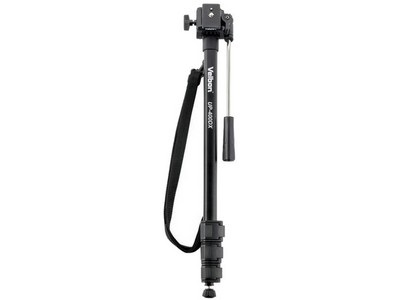How to choose a monopod
Monopods are one-legged tripods that provide extra camera support without losing the ability to respond and adjust quickly. As a result, they are popular in sports and reportage photography. Monopods offer a cheaper alternative to lenses with optical image stabilisation. Furthermore, they are lighter and more portable than tripods.

Frequently asked questions when choosing a monopod
Do monopods come with a tripod head?
Not always. Most monopod models come with a head, especially those designed for beginners; professional monopods, on the other hand, often leave the choice of head to the photographer.
I'm a novice photographer and am not sure which type of photography to focus on. Is a monopod suitable for my needs?
For beginners, a tripod is preferable as monopods are designed for relatively specialised types of photography, such as sports and reportage.
What advantages do monopods have over tripods?
Compared with tripods, monopods are smaller and lighter, making them easier to carry and pack. They also allow the photographer to react and move faster than with tripods, making them better suited to sports and reportage photography.
Important parameters


Dimensions
To ensure comfort and convenience, the tripod should allow the camera to be mounted at a sufficient height that you don't have to stoop in order to look through the viewfinder. However, a higher maximum height will be reflected in a higher weight. For some types of photography a minimum height is also necessary, for example macro photography.
The maximum height of a tripod does not necessarily reflect its size when folded; the number of leg segments also influences a tripod's minimum dimensions. The higher the number of segments, the more height-adjustable the tripod, and the smaller it can be folded. However, a higher number of segments can have a negative impact on stability and vibration resistance. Most tripods have three or four leg segments, but some specialised studio tripods have only one segment.

Maximum load
The maximum load indicates the maximum weight of the equipment that the tripod can support. To prevent falls or instability, however, it is not recommended to go over 50% of the maximum load.
A higher maximum load is needed primarily when shooting with heavy lenses, which are usually associated with sports and wildlife photography.
Glossary - Tripods
Tripod
A tripod is essential piece of photographic kit used to stabilise the camera during longer exposure times.
Tripod head
The tripod head attaches the supported device (e.g. a camera) to the tripod legs and allows the device to be locked or positioned in different ways. Tripod heads differ according to the clamping mechanism used and the method of adjusting the axis.
Image stabilisation
Image stabilisation helps to prevent blur caused by camera shake. You should consider getting a lens with image stabilisation if you often use zoom or shoot without a tripod.


Material and weight
The material used is the primary factor affecting the weight of a tripod. Weight particularly becomes an issue for outdoor photography, when you may trek several miles with all your kit to find the perfect spot. If a tripod is too lightweight, however, it can negatively affect its stability.
Most tripods are made of metal, such as aluminium alloys, composites, and titanium. You may even come across wooden tripods, but these are unsuitable for most conventional photography.
Aluminium alloys - strong and yet relatively inexpensive, this is the most commonly used material.
Composite materials - lighter than aluminium but also more expensive.
Titanium - a light and strong metal, titanium tripods tend to be more expensive than others.